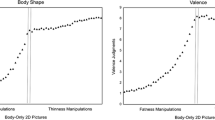Abstract
This study aimed to provide data concerning the validity of a short sequence of face valid pictorial stimuli assessing the perception of body size in school-age children. A sequence of gender and age-appropriate silhouettes was administered to 314 boys and girls aged 6–14 years. The self-evaluations provided by the children correlated significantly with their actual BMI corrected for age. Furthermore, the children’s self-evaluations always significantly correlated with the evaluations provided by the three external observers; i.e., both parents and the interviewers. The results indicate that this sequence of pictorial stimuli, depicting realistic human forms appropriate for children, is a valid measure of children’s body image. Relevant differences across age groups were also found, indicating that before the age of eight, the correlations between the children’s self-evaluations and their BMI or the judgments of the three observers are lower than in the other age groups.
Similar content being viewed by others
References
Cash TF (2002) Cognitive-behavioral perspectives on body image. In: Cash TF, Pruzinsky T (eds) Body image: a handbook of theory, research, and clinical practice. The Guilford Press, New York, pp 38–46
Shroff H, Calogero R, Thompson JK (2009) Assessment of body image. In: Allison DB, Baskin ML (eds) Handbook of assessment methods for eating behaviours and weight-related problems. Measures, theory, and research, 2nd edn. SAGE Publications, US, pp 115–136
Cash TF, Smolak L (2011) Body image: a handbook of science, practice, and prevention, 2nd edn. Guilford Press, New York
Grogan S (1999) Body image: understanding body dissatisfaction in men, women and children. Routledge, London
Grogan S, Shepherd S, Evans R et al (2006) Experiences of anabolic steroid use: in-depth interviews with men and women body builders. J Health Psychol 11:845–856
Santos Silva DA, Nahas MV, de Sousa TF et al (2011) Prevalence and associated factors with body image dissatisfaction among adults in southern Brazil: a population-based study. Body Image 8:427–431
Thomas J, Khan S, Abdulrahman AA (2010) Eating attitudes and body image concerns among female university students in the United Arab Emirates. Appetite 54:595–598
Mulasi-Pokhriyal U, Smith C (2010) Assessing body image issues and body satisfaction/dissatisfaction among American children 9–18 years of age using mixed methodology. Body Image 7:341–348
Duncan MJ, Al-Nakeeb Y, Nevill AM, Jones MV (2006) Body dissatisfaction, body fat and physical activity in British children. Int J Pediatr Obes 1:89–95
Stunkard A, Sørensen T, Schulsinger F (1983) Use of the danish adoption register for the study of obesity and thinness. In: Kety S, Roland L, Sidman R, Matthysse S (eds) The genetics of neurological and psychiatric disorders. Raven Press, New York, pp 115–120
Fallon AE, Rozin P (1985) Sex differences in perceptions of desirable body shape. J Abnorm Psychol 94:102–105
Thompson MA, Gray JJ (1995) Development and validation of a new body-image assessment scale. J Pers Assess 64:258–269
Gardner RM (2002) Body image assessment of children. In: Cash TF, Pruzinsky T (eds) Body image: a handbook of theory, research, and clinical practice. The Guilford Press, New York, pp 127–134
Cash TF (2011) Crucial considerations in the assessment of body image. In: Cash TF, Smolak L (eds) Body image: a handbook of science, practice, and prevention, 2nd edn. Guilford Press, New York, pp 39–47
Hill AJ (2011) Body image assessment of children. In: Cash TF, Smolak L (eds) Body image: a handbook of science, practice, and prevention, 2nd edn. Guilford Press, New York, pp 138–145
Smolak L (2002) Body image development in children. In: Cash TF, Pruzinsky T (eds) Body image: a handbook of theory, research, and clinical practice. The Guilford Press, New York, pp 65–73
Gardner RM, Brown DL (2010) Body image assessment: a review of figural drawing scales. Pers Individ Dif 48:107–111
Wertheim EH, Paxton SJ, Tilgner L (2004) Test-retest reliability and construct validity of contour drawing rating scale scores in a sample of early adolescent girls. Body Image 1:199–205
Collins ME (1999) Body figure perceptions and preferences among preadolescent children. Int J Eat Disord 10:199–208
Thompson JK (1996) Assessing body image disturbance: measures, methodology, and implementation. In: Thompson JK (ed) Body image, eating disorders, and obesity. American Psychological Association, Washington, DC, pp 49–81
Altabe M (1996) Issues in the assessment and treatment of body image disturbance in culturally diverse populations. In: Thompson JK (ed) Body image, eating disorders, and obesity. American Psychological Association, Washington, DC, pp 129–148
Gardner RM, Jappe LM, Gardner L (2009) Development and validation of a new figural drawing scale for body-image assessment: the BIAS-BD. J Clin Psychol 65:113–122
Gardner RM, Friedman BN, Jackson NA (1998) Methodological concerns when using silhouettes to measure body image. Percept Mot Skills 86:387–395
World Health Organization (2009) WHO AnthroPlus for personal computers manual: software for assessing growth of the world’s children and adolescents. WHO, Geneva
Conflict of interest
The authors declare that they all have no conflict of interest.
Author information
Authors and Affiliations
Corresponding author
Rights and permissions
About this article
Cite this article
Lombardo, C., Battagliese, G., Pezzuti, L. et al. Validity of a figure rating scale assessing body size perception in school-age children. Eat Weight Disord 19, 329–336 (2014). https://doi.org/10.1007/s40519-013-0085-0
Received:
Accepted:
Published:
Issue Date:
DOI: https://doi.org/10.1007/s40519-013-0085-0




